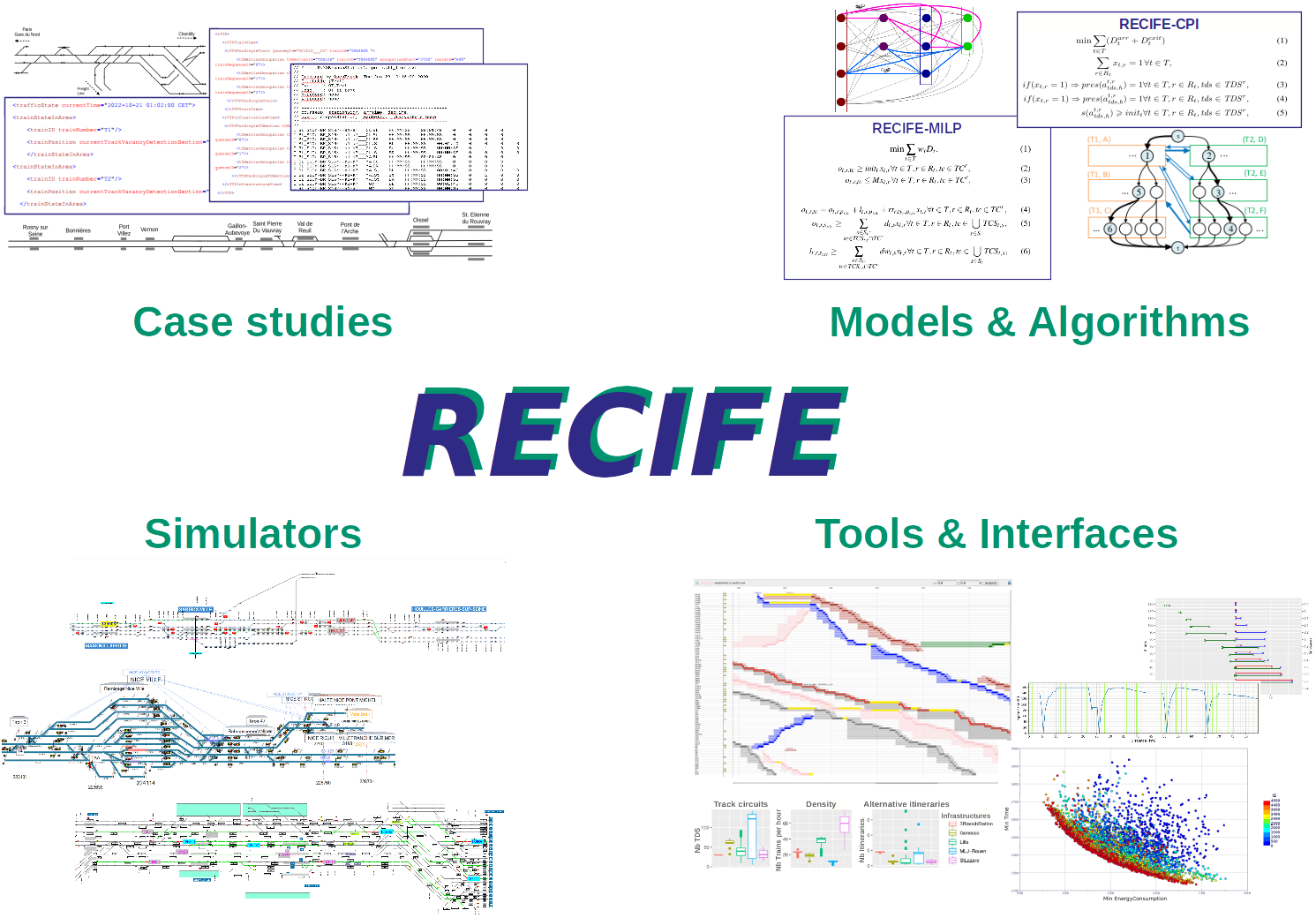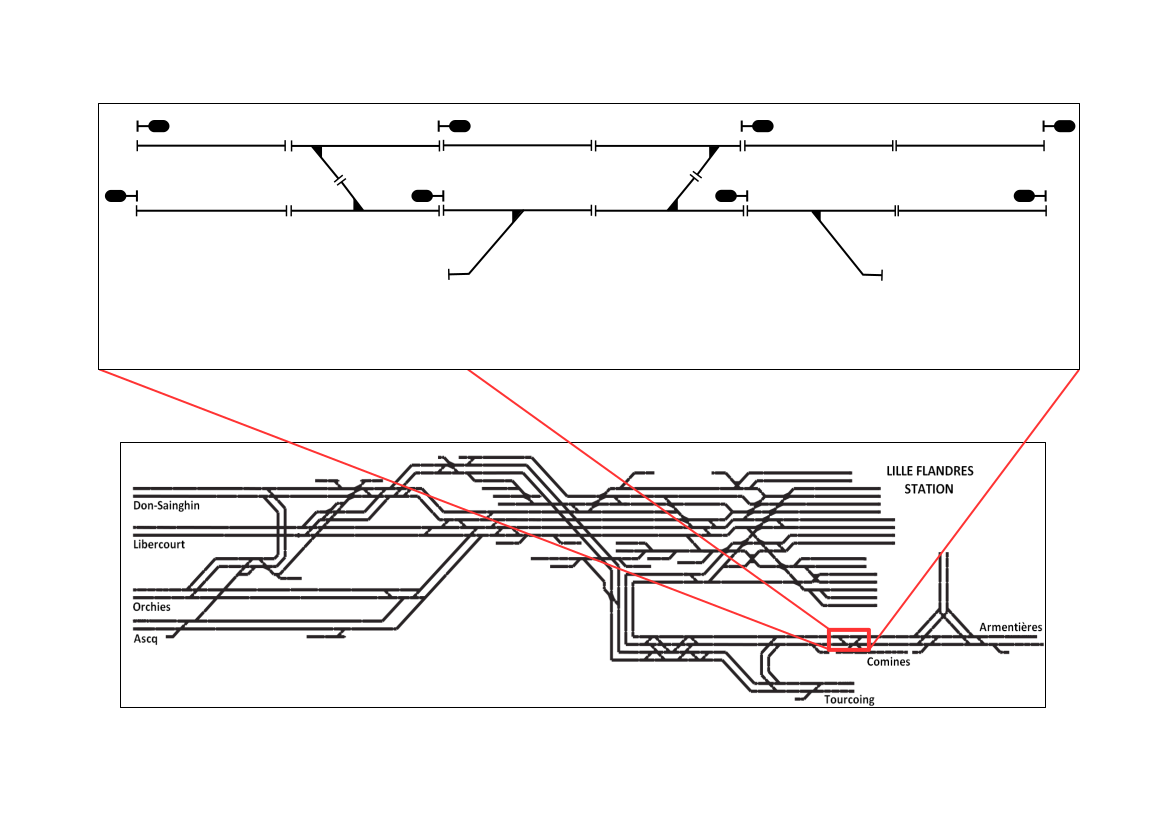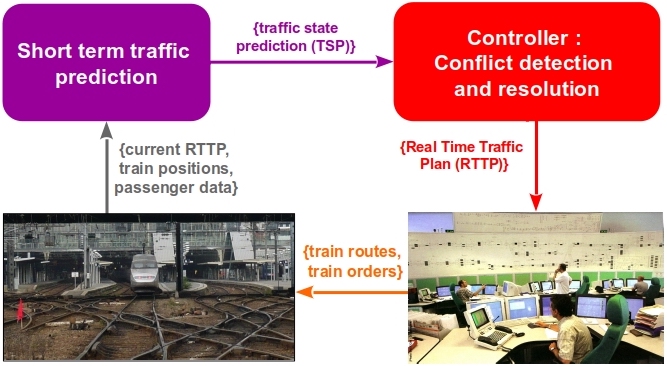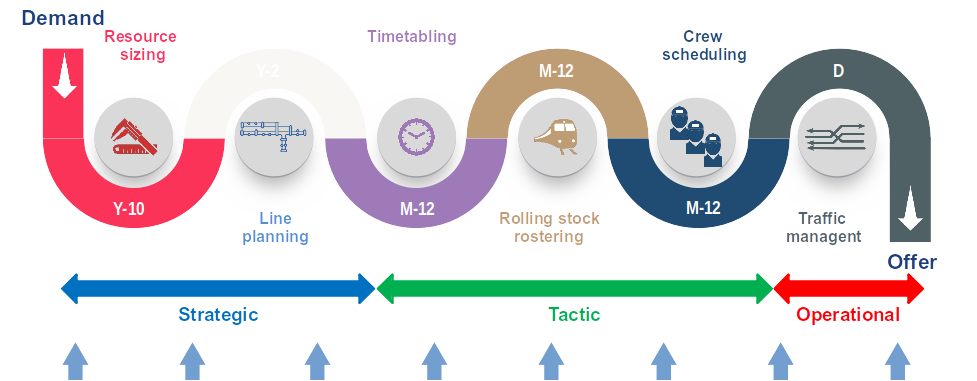Traffic Management
This research topic focuses on proposing and analyzing optimization techniques for various processes at the heart of the railway system, with the aim of increasing efficiency. In particular, most of the research is aimed at exploiting infrastructure capacity and improving service levels.
In this research action, we are tackling, for example, the following problems: saturation of a rail network, operational traffic management, generation of timetables and definition of energy-saving driving profiles. Traditional technologies as well as the latest trends in rail system modernization (e.g., moving block, automatic driving) are considered in the research works.
The techniques proposed to solve these problems are based on operations research and artificial intelligence.
This research is being carried out as part of the development of the RECIFE platform (research on the capacity of railway infrastructures - REcherche sur la Capacité des Infrastructure FErroviaires). This platform was developed in the 1990s and is constantly evolving to meet the needs of the sector.

The RECIFE platform includes a collection of case studies and integrates simulation and optimization tools with analysis and human-machine interface instruments.
Several features distinguish this platform from the majority of tools used in the scientific community.
Microscopic model of infrastructures and train movements
In RECIFE, the modeling of the railway system is based on the microscopic observation of its characteristics and functioning. Virtually all the approaches proposed and the studies carried out consider such modeling.
This implies a considerable data processing effort, and an imperative need of efficiency of the algorithms that must be able to process these large quantities of data.
In return for these challenges, the solutions provided by the algorithms can fully exploit the actual capacity of the system and can be directly deployed.

Integration of Simulation and Optimization
In RECIFE, the algorithms proposed and developed by the traffic management team of the ESTAS laboratory are regularly interfaced with microscopic rail traffic simulators, to study their behavior and performance disregarding the modeling assumptions made. In particular, in these studies, simulation replaces reality, enabling the experimentation to be as close as possible to an actual deployed.
Examples of such experimentation are the studies carried our within the SIGIFRET and the ONTIME projects. In these two projects, the focus is on operational rail traffic management. In SIGIFRET, the optimization algorithm RECIFE-MILP has been connected to the Opentrack simulator. In ONTIME, it has been integrated in closed-loop with the Hermes simulator.
In a recent application, a traffic self-organization approach is integrated in closed-loop with the Opentrack simulator. The latter has also been combined to a microscopic passenger simulator. This application has been developed within the SORTEDMOBILITY project.

Modeling Consistency
In RECIFE, the entirety of the railway transport planning process is considered, taking into account several problems that emerge at different times.
These problems are addressed by proposing closely related models, to ensure that decisions made are consistent at different levels, and to exploit the cross-fertilization of knowledge.
Whenever possible, several problems traditionally treated separately in the literature are solved jointly to improve the overall system performance. For example, the joint resolution of line and timetable planning problems has been successfully studied.

Team
Current projects
| Dates | Titre | Contact ESTAS |
|---|---|---|
| 2023-2027 | REINFORCERAIL Railway EffIcieNcy Fostered by Operations ResearCh EmpoweRing Articificial InteLligence | PELLEGRINI Paola | Partenaires : SNCF Innovation & Recherche, TU Dresden REINFORCERAIL proposes a new Traffic Management System component based on AI. On one side, neural networks identify which trains possibly need rescheduling at which time. On the other, AI agents are hybridized with OR methods to effectively explore the search space. |
| 2022-2027 | Chaire - Sécurité du système ferroviaire | PELLEGRINI Paola | Partenaires : CERTIFER, GAPAVE The Chair aims to build and implement a scientific work program intended to support certification stakeholders in their missions of evaluating the safety of rail systems, taking into account the new challenges these systems face. |
| 2022-2026 | MOTIONAL MObility managemenT multImodal envirOnment aNd digitAl enabLers | PELLEGRINI Paola | Site : https://projects.rail-research.europa.eu/eurail-fp1/ Partenaires : HACON, ADIF, ATSA, MERMEC, AZD PRAHA SRO, CAF, CEIT, DB, DLR, ENYSE, ETRA I+D, FT, FS , Hitachi Rail, INDRA, NRD, KB, ÖBB-Infra, PKP, ProRail, NSR, SNCF, Trafikverket, vaRS, MDM, GTSD, SJ AB, FGC MOTIONAL aims to develop a future European TMS that is interoperable, resilient, able to adapt the capacity and to integrate all involved services, including last mile operations provided by other transport modes, by taking advantage of the potential of digitalisation. |
| 2023-2025 | Algorithmes TrenoLab Participation à la conception d'algorithmes | PELLEGRINI Paola | Partenaire : TrenoLab The collaboration is part of the TRENOlab development of tools for the optimization of problems related to the design of rail services. Université Gustave Eiffel participates through discussions on the implementation and refinement of algorithmic choices. |
| 2023-2025 | FERROMOBILE | RODRIGUEZ Joaquin | Site : https://ferromobile.fr/ Partenaires : SICEF, AKKODIS, SYSTRA, Entropy In the context of an innovative transport system adapted to fine service lines, based on a fleet of hybrid, autonomous and shared road-rail vehicles, the team must design an algorithm to configure a line composed of single-track sections between the stations. This algorithm will aim to optimize the crossing points between stations according to a predefined timetable structure and to be able to best respond to on-demand services. |
Completed projects
| Dates | Titre | Contact ESTAS |
|---|---|---|
| 2021-2024 | SORTEDMOBILITY Self-Organized Rail Traffic for the Evolution of Decentralized MOBILITY | PELLEGRINI Paola | Site : https://www.sortedmobility.eu/ Partenaires : SNCF, DTU, RFI, TU DELFT, BANEDANMARK SORTEDMOBILITY stands for Self-Organized Rail Traffic for the Evolution of Decentralized MOBILITY. It proposes a holistic approach for self-organizing management of public transport operations in urban and interurban areas. |
| 2020-2022 | TrenoLab-NO Collaboration avec TrenoLab sur la conception d'un algorithme de génération de grille horaire pour le réseau ferroviaire Norvégien | PELLEGRINI Paola | Partenaire : TrenoLab We propose a multi-objective ant colony optimization algorithm to tackle the train timetabling problem. We consider several objective functions, as global travel times, energy consumption and number of scheduled trains. |
| 2019-2022 | Navette à la demande Conception et test d’un algorithme d’optimisation pour la planification temps-réel d’un service de transport de passagers à la demande sur voie dédiée. | PELLEGRINI Paola | Design and testing of an optimization algorithm for the real-time planning of an on-demand passenger transport service on a dedicated lane. |
| 2020-2021 | RERBD2025 Simulation exploitation lignes B et D Avec régulation optimisée | MARLIERE Grégory | Partenaire : SNCF Réseau Based on the modernization of the equipment of the RER B and D lines by 2025, this study aims to highlight the regulation strategies to be implemented to maximize the level of performance of the future RER B/D system from the point of view of travelers. |
| 2018-2021 | LIERE Liaison Ingetime Et REcife | MARLIERE Grégory | This Project aims to facilitate interoperability between a timetable design and validation tool (IngéTime/RailConcept) and a traffic optimization tool (RECIFE/UGE). |
| 2017-2021 | Projet Fédérateur ITE Infrastructures de Transition Energétique | PELLEGRINI Paola |
| 2017-2021 | 1-2 Optimisation débit/énergie des trafics routiers et ferroviaires Logiciel de gestion optimale à grande échelle de la capacité ferroviaire | RODRIGUEZ Joaquin | Site : http://recife.univ-eiffel.fr/SeminaireCOP2017-2021/presentations/ Partenaires : Railenium, SNCF Réseau Better route planning, eco-driving assistance, large-scale optimization of rail traffic, multimodal and multi-scale simulation of travel and traffic flows |
| 2015-2020 | VAL 52M | RODRIGUEZ Joaquin | Doubling the capacity of line 1 of the Lille Metro. |
| 2018-2019 | Fluidification du RER C Simultation dynamique de la fluidification de la ligne RER C | MARLIERE Grégory | Partenaire : SNCF Innovation & Recherche This project aims to study, using a simulation test bench (UGE), the impact of a fluidification algorithm by retention of trains in stations (SNCF I&R) on RER C traffic. It follows the RER fluidification projects A and ImpactKVB-P |
| 2017-2019 | OPTIYARD Optimised Real-time Yard and Network Management | PELLEGRINI Paola | Partenaires : SAPIENZA UNIVERSITA DI ROMA, UIC, University of Newcastle upon Tyne, University of Leeds, EURNEX e. V., OLTIS GROUP AS, NEW OPERA AISBL, Simcon, Université technique de Dresde, Adriafer srl OptiYard has developed a prototype decision support tool to improve the efficiency of freight train management in rail yards. The prototype is based on the integration of a simulation module and an optimization module. The first is a commercial simulator developed by the Simcon company, the second was developed at UGE during the project. |
| 2017-2019 | SYSAUTO Systèmes autonomiques pour le trafic ferroviaire | PELLEGRINI Paola | The main objective of the research concerns the design and development of new algorithms and tools for the management of rail traffic modeled as an autonomous system, taking into account both automation and traffic optimization. |
| 2018-2018 | ImpactKVBP | MARLIERE Grégory | Partenaire : SNCF Innovation & Recherche This project aimed to study, using a simulation test bench (UGE), the impact of a fluidification algorithm by retention of trains in stations (SNCF I&R) on RER traffic in the specific case of using the system. signaling KVB-P |
| 2017-2018 | INDIGO INteropérabilité des Données d’ Infrastructure Gaïa-Opentrack | MARLIERE Grégory | Partenaire : SNCF Réseau This project, carried out in collaboration with SNCF TECH4RAIL and the company Quematech, aims to facilitate interoperability between SNCF proprietary databases (GAIA) and simulation and optimization tools, through the use of the standard RailML data format. |
| 2015-2016 | Simulation du trafic ferroviaire | MARLIERE Grégory | Partenaire : SNCF Innovation & Recherche This project aimed to study, using a simulation test bench (UGE), the impact of a fluidification algorithm by retention of trains in stations (SNCF I&R) on RER A and L3 traffic. |
| 2012-2015 | SIGIFret Simulations d’une gestion innovante des circulations fret | MARLIERE Grégory | Partenaires : SNCF Réseau Evaluation of a traffic flow system whose aim is to facilitate the integration of freight trains into passenger traffic. |
| 2011-2014 | On-Time Optimal Networks for Train Integration Management across Europe | RODRIGUEZ Joaquin | The overall aim of the ON-TIME project was to improve railway customer satisfaction through increased capacity and decreased delays for passenger and freight trains. |
| Groupe de travail Navette autonome | HOSTEINS Pierre |